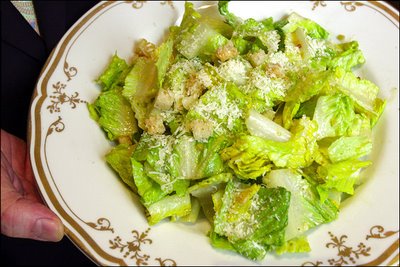
Note to the caption: .FD-CAESAR Date: 03-23-06 Photographer: Susan Biddle/TWP Neg#178645 Location: Washington, DC Summary: Caesar salad as prepared at the Willard Room in Willard Hotel by Willard Room Director Francisco Nieto. The completed salad. StaffPhoto imported to Merlin on Thu Mar 23 20:44:02 2006 Photo Credit: Twp Photo
The Salad That Conquered the Country
Wednesday, March 29, 2006; F01
America cannot get enough of the Caesar salad. In the last two decades, the simple combination of romaine lettuce, creamy dressing and Parmesan cheese has:
· Become America's most popular main-dish salad, showing up virtually everywhere from fast-food chains to white-tablecloth restaurants to the takeout counter in the supermarket.
· Dramatically altered the lettuce industry as the demand for romaine has skyrocketed.
· Turned the chicken-topped Caesar into the chicken item most frequently found on restaurant menus -- more often than wings or even that perennial kid favorite, chicken fingers.
And still we want more.
Three-fourths of all full-service restaurants now offer a Caesar salad, compared with 57 percent just a year ago, according to a new survey of the country's top 500 restaurants by market research firm Technomic.
Dole Foods, which introduced the bagged Caesar salad kit 12 years ago, says sales of its classic Caesar kit continue to grow each year, despite competition from other companies and Dole's own eight other bagged salad kits. "Americans just don't get tired of that flavor," says Eric Schwartz, president of Dole's fresh vegetable division.
Although the Caesar may seem like the all-American salad, it actually was invented in 1924 by an Italian immigrant in Mexico.
Caesar Cardini, owner of a popular Tijuana restaurant, concocted the salad one night for some late-partying Hollywood guests, most food historians agree. He used romaine, then considered an uncommon delicacy, and just six ingredients to make a creamy dressing: garlic, olive oil, lemon, egg, Worcestershire sauce and Parmesan cheese.
The salad was prepared tableside, and posh restaurants in Los Angeles soon began offering it as well.
"The ingredients today don't impress us, but back then they were much more expensive and difficult to find. The Caesar, when it was first introduced, was considered exotic," says Vogue magazine food critic and author Jeffrey Steingarten.
As ingredients like olive oil and Parmesan cheese became more common, however, the Caesar made the jump from upper-class rarity to mass-culture staple.
Demand for the salad grew and the effect began to be felt in the lettuce industry. Over the past 15 years, romaine has gone from a tiny portion of the nation's lettuce crop to one of the fastest-growing vegetables to be produced, consumed and exported, according to the U.S. Department of Agriculture's Economic Research Service.
Romaine production has soared so dramatically that in 2002, for the first time, the USDA's agricultural census gave romaine its own category. According to the government's figures, California, the country's largest lettuce producer, grew romaine on 15,500 acres in 1992. By 2004, that had quadrupled to 64,000 acres.
The Caesar also has proved a boon to the poultry industry, thanks to the idea of topping the salad with strips of chicken to turn it into an entree.
A 2003 survey of about 1,400 restaurants conducted for the National Chicken Council found that the chicken Caesar was on 66 percent of restaurant menus; chicken fingers showed up on 50 percent. "We were surprised. We thought wings or tenders would be higher [than the Caesar]. But I guess it's the universal chicken dish," says council spokesman Richard Lobb.
The popularity of the Caesar, particularly as an entree salad topped with chicken, beef or fish, is expected to keep on growing.
The National Restaurant Association's 2005 restaurant industry forecast showed entree-salad orders registering the largest increase of all menu items at both full-service and quick-service restaurants. Nearly 80 percent of quick-service places reported that customers are ordering entree salads, such as the Caesar, more often.
And it's not popular only in the United States. When Didier Armand, chef at the Paris La Defense hotel, was named Renaissance Hotels' chef of the year in 2005, he noted at a luncheon that no matter what he put on the hotel's lunch menu, "the chicken Caesar always outsells everything."
Who says it's only for rabbits?
Consumption of all lettuce varieties has been increasing since 1960. Iceberg remains the most popular, but we're eating less of it and more of romaine. In 1985, per capita consumption of romaine was less than one pound. By 2004, that had increased to 8.1 pounds, nearly doubling between 2001 and 2004, due in part to the increased popularity of the Caesar salad.
(Source: USDA Economic Research Service)
Get dressed
Although ranch dressing is the most popular at home, Caesar is the dressing most likely to appear on restaurant menus.
(Source: Mintel menu monitor base, 2005)
By calories and pounds
It may be a salad, but it's not necessarily low-calorie. Some examples, with dressing: A nine-ounce chicken Caesar from Au Bon Pain is 920 calories (60 grams of fat); a 14-ounce salad from Panera is 560 calories (34 grams fat); and an 11-ounce salad from McDonald's is 470 calories (25 grams fat).
For its 861 hotels in North America that serve Caesar salads, Marriott International in 2005 bought nearly 2 million pounds of romaine lettuce.
(Source: Restaurant Web sites; Marriott International)
link to the original posting
No comments:
Post a Comment